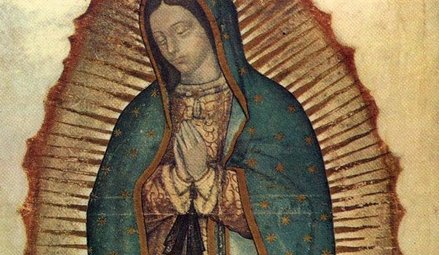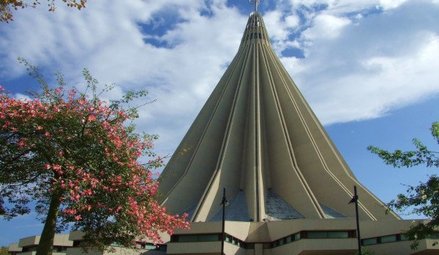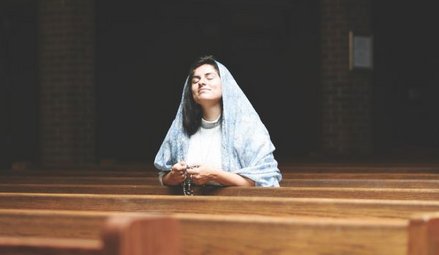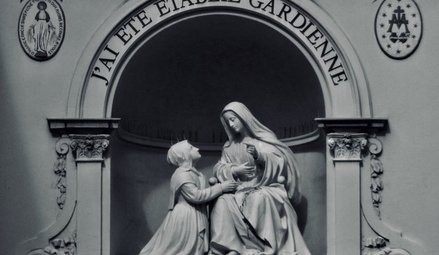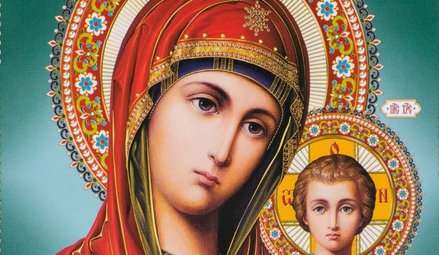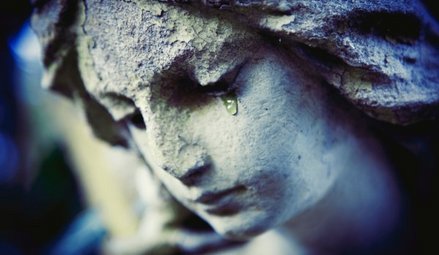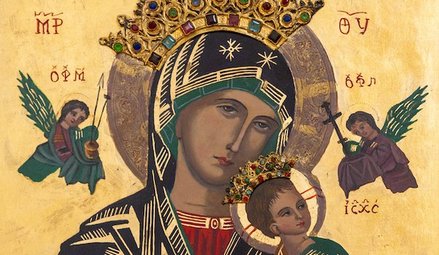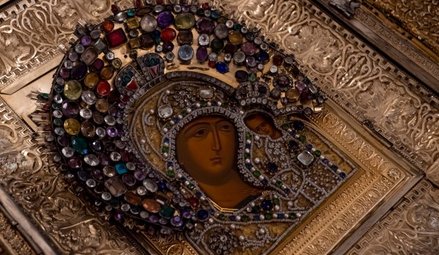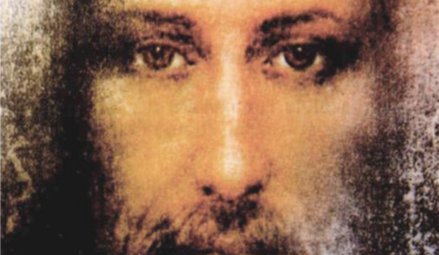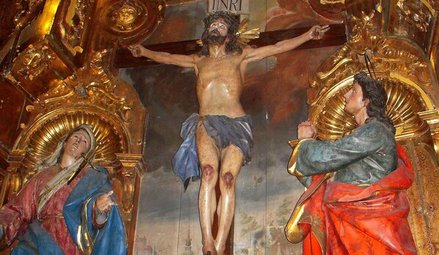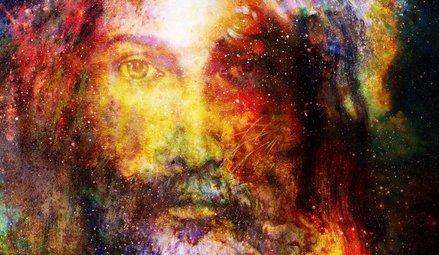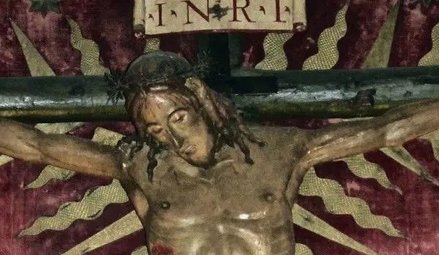- By theme
- Jesus
- The many proofs of Christ’s resurrection
- Saint Thomas Aquinas: God gave all the divine proofs we needed to believe
- The surpassing power of Christ's word
- Lewis’s trilemma: a proof of Jesus’s divinity
- God saves: the power of the holy name of Jesus
- Jesus spoke and acted as God's equal
- Jesus' divinity is actually implied in the Koran
- Jesus came at the perfect time of history
- Rabbinical sources testify to Jesus' miracles
- Mary
- The Church
- The Bible
- An enduring prophecy and a series of miraculous events preventing the reconstruction of the Temple
- The authors of the Gospels were either eyewitnesses or close contacts of those eyewitnesses
- Onomastics support the historical reliability of the Gospels
- The New Testament was not altered
- The New Testament is the best-attested manuscript of Antiquity
- The Gospels were written too early after the facts to be legends
- Archaeological finds confirm the reliability of the New Testament
- The criterion of embarrassment proves that the Gospels tell the truth
- The dissimilarity criterion strengthens the case for the historical reliability of the Gospels
- 84 details in Acts verified by historical and archaeological sources
- The unique prophecies that announced the Messiah
- The time of the coming of the Messiah was accurately prophesied
- The prophet Isaiah's ultra accurate description of the Messiah's sufferings
- Daniel's "Son of Man" is a portrait of Christ
- The Apostles
- Saint Peter, prince of the apostles
- Saint John the Apostle: an Evangelist and Theologian who deserves to be better known (d. 100)
- Saint Matthew, apostle, evangelist and martyr (d. 61)
- James the Just, “brother” of the Lord, apostle and martyr (d. 62 AD)
- Saint Matthias replaces Judas as an apostle (d. 63)
- The martyrs
- The protomartyr Saint Stephen (d. 31)
- Polycarp, bishop of Smyrna, disciple of John and martyr (d. 155)
- Justin Martyr: philosopher and apologist (d.165)
- Saint Blandina and the Martyrs of Lyon: the fortitude of faith (177 AD)
- Saint Agatha stops a volcano from destroying the city of Catania (d. 251)
- Saint Lucy of Syracuse, virgin and martyr for Christ (d. 304)
- Saint Boniface propagates Christianity in Germany (d. 754)
- Thomas More: “The king’s good servant, but God’s first”
- The martyrdom of Paul Miki and his companions (d. 1597)
- The martyrs of Angers and Avrillé (1794)
- The Martyrs of Compiègne (1794)
- The Vietnamese martyrs Father Andrew Dung-Lac and his 116 companions (17th-19th centuries)
- He braved torture to atone for his apostasy (d. 1818)
- Blaise Marmoiton: the epic journey of a missionary to New Caledonia (d. 1847)
- The Uganda martyrs: a recurring pattern in the persecution of Christians (1885)
- José Luis Sanchez del Rio, martyred at age 14 for Christ the King (d. 1928)
- Saint Maximilian Kolbe, Knight of the Immaculate (d. 1941)
- The monks
- The Desert Fathers (3rd century)
- Saint Anthony of the Desert, a father of monasticism (d. 356)
- Saint Benedict, father of Western monasticism (d. 550)
- Saint Bruno the Carthusian (d.1101): the miracle of a hidden life
- Blessed Angelo Agostini Mazzinghi: the Carmelite with flowers pouring from his mouth (d. 1438)
- Monk Abel of Valaam's accurate prophecies about Russia (d. 1841)
- The more than 33,000 miracles of Saint Charbel Maklouf (d. 1898)
- Saint Pio of Pietrelcina (d. 1968): How God worked wonders through "a poor brother who prays"
- The surprising death of Father Emmanuel de Floris (d. 1992)
- The prophecies of Saint Paisios of Mount Athos (d. 1994)
- The saints
- Saints Anne and Joachim, parents of the Virgin Mary (19 BC)
- Saint Nazarius, apostle and martyr (d. 68 or 70)
- Ignatius of Antioch: successor of the apostles and witness to the Gospel (d. 117)
- Saint Gregory the Miracle-Worker (d. 270)
- Saint Martin of Tours: patron saint of France, father of monasticism in Gaul, and the first great leader of Western monasticism (d. 397)
- Saint Augustine of Canterbury evangelises England (d. 604)
- Saint Lupus, the bishop who saved his city from the Huns (d. 623)
- Saint Rainerius of Pisa: from musician to merchant to saint (d. 1160)
- Saint Dominic of Guzman (d.1221): an athlete of the faith
- Saint Francis, the poor man of Assisi (d. 1226)
- Saint Anthony of Padua: "everyone’s saint"
- Saint Rose of Viterbo or How prayer can transform the world (d. 1252)
- Saint Simon Stock receives the scapular of Mount Carmel from the hands of the Virgin Mary
- The unusual boat of Saint Basil of Ryazan
- Saint Agnes of Montepulciano's complete God-confidence (d. 1317)
- The extraordinary conversion of Michelina of Pesaro
- Saint Peter Thomas (d. 1366): a steadfast trust in the Virgin Mary
- Saint Rita of Cascia: hoping against all hope
- Saint Catherine of Genoa and the Fire of God's love (d. 1510)
- Saint Anthony Mary Zaccaria, physician of bodies and souls (d. 1539)
- Saint Ignatius of Loyola (d. 1556): "For the greater glory of God"
- Brother Alphonsus Rodríguez, SJ: the "holy porter" (d. 1617)
- Martin de Porres returns to speed up his beatification (d. 1639)
- Virginia Centurione Bracelli: When God is the only goal, all difficulties are overcome (d.1651)
- Saint Marie of the Incarnation, "the Teresa of New France" (d.1672)
- St. Francis di Girolamo's gift of reading hearts and souls (d. 1716)
- Rosa Venerini: moving in the ocean of the Will of God (d. 1728)
- Saint Jeanne-Antide Thouret: heroic perseverance and courage (d. 1826)
- Seraphim of Sarov (1759-1833): the purpose of the Christian life is to acquire the Holy Spirit
- Camille de Soyécourt, filled with divine fortitude (d. 1849)
- Bernadette Soubirous, the shepherdess who saw the Virgin Mary (1858)
- Saint John Vianney (d. 1859): the global fame of a humble village priest
- Gabriel of Our Lady of Sorrows, the "Gardener of the Blessed Virgin" (d. 1862)
- Father Gerin, the holy priest of Grenoble (1863)
- Blessed Francisco Palau y Quer: a lover of the Church (d. 1872)
- Saints Louis and Zelie Martin, the parents of Saint Therese of Lisieux (d. 1894 and 1877)
- The supernatural maturity of Francisco Marto, “contemplative consoler of God” (d. 1919)
- Saint Faustina, apostle of the Divine Mercy (d. 1938)
- Brother Marcel Van (d.19659): a "star has risen in the East"
- Doctors
- The mystics
- Lutgardis of Tongeren and the devotion to the Sacred Heart
- Saint Angela of Foligno (d. 1309) and "Lady Poverty"
- Saint John of the Cross: mystic, reformer, poet, and universal psychologist (+1591)
- Blessed Anne of Jesus: a Carmelite nun with mystical gifts (d.1621)
- Catherine Daniélou: a mystical bride of Christ in Brittany
- Saint Margaret Mary sees the "Heart that so loved mankind"
- Jesus makes Maria Droste zu Vischering the messenger of his Divine Heart (d. 1899)
- Mother Yvonne-Aimée of Jesus' predictions concerning the Second World War (1922)
- Sister Josefa Menendez, apostle of divine mercy (d. 1923)
- Edith Royer (d. 1924) and the Sacred Heart Basilica of Montmartre
- Rozalia Celak, a mystic with a very special mission (d. 1944)
- Visionaries
- Saint Perpetua delivers her brother from Purgatory (203)
- María de Jesús de Ágreda, abbess and friend of the King of Spain
- Discovery of the Virgin Mary's house in Ephesus (1891)
- Sister Benigna Consolata: the "Little Secretary of Merciful Love" (d. 1916)
- Maria Valtorta's visions match data from the Israel Meteorological Service (1943)
- Berthe Petit's prophecies about the two world wars (d. 1943)
- Maria Valtorta saw only one pyramid at Giza in her visions... and she was right! (1944)
- The location of Saint Peter's village seen in a vision before its archaeological discovery (1945)
- The 700 extraordinary visions of the Gospel received by Maria Valtorta (d. 1961)
- The amazing geological accuracy of Maria Valtorta's writings (d. 1961)
- Maria Valtorta's astronomic observations consistent with her dating system
- Discovery of an ancient princely house in Jerusalem, previously revealed to a mystic (d. 1961)
- Mariette Kerbage, the seer of Aleppo (1982)
- The 20,000 icons of Mariette Kerbage (2002)
- The popes
- The great witnesses of the faith
- Saint Augustine's conversion: "Why not this very hour make an end to my uncleanness?" (386)
- Thomas Cajetan (d. 1534): a life in service of the truth
- Madame Acarie, "the servant of the servants of God" (d. 1618)
- Blaise Pascal (d.1662): Biblical prophecies are evidence
- Madame Élisabeth and the sweet smell of virtue (d. 1794)
- Jacinta, 10, offers her suffering to save souls from hell (d. 1920)
- Father Jean-Édouard Lamy: "another Curé of Ars" (d. 1931)
- Christian civilisation
- The depth of Christian spirituality
- John of the Cross' Path to perfect union with God based on his own experience
- The dogma of the Trinity: an increasingly better understood truth
- The incoherent arguments against Christianity
- The "New Pentecost": modern day, spectacular outpouring of the Holy Spirit
- The Christian faith explains the diversity of religions
- Cardinal Pierre de Bérulle (d.1629) on the mystery of the Incarnation
- Christ's interventions in history
- Marian apparitions and interventions
- The Life-giving Font of Constantinople
- Apparition of Our Lady of La Treille in northern France: prophecy and healings (600)
- Our Lady of Virtues saves the city of Rennes in Bretagne (1357)
- Mary stops the plague epidemic at Mount Berico (1426)
- Our Lady of Miracles heals a paralytic in Saronno (1460)
- Cotignac: the first apparitions of the Modern Era (1519)
- Savona: supernatural origin of the devotion to Our Lady of Mercy (1536)
- The Virgin Mary delivers besieged Christians in Cusco, Peru
- The victory of Lepanto and the feast of Our Lady of the Rosary (1571)
- The apparitions to Brother Fiacre (1637)
- The “aldermen's vow”, or the Marian devotion of the people of Lyon (1643)
- Our Lady of Nazareth in Plancoët, Brittany (1644)
- Our Lady of Laghet (1652)
- Saint Joseph’s apparitions in Cotignac, France (1660)
- Heaven confides in a shepherdess of Le Laus (1664-1718)
- Zeitoun, a two-year miracle (1968-1970)
- The Holy Name of Mary and the major victory of Vienna (1683)
- Heaven and earth meet in Colombia: the Las Lajas shrine (1754)
- The five Marian apparitions that traced an "M" over France, and its new pilgrimage route
- A series of Marian apparitions and prophetic messages in Ukraine since the 19th century (1806)
- "Consecrate your parish to the Immaculate Heart of Mary" (1836)
- At La Salette, Mary wept in front of the shepherds (1846)
- Our Lady of Champion, Wisconsin: the first and only approved apparition of Mary in the US (1859)
- Gietrzwald apparitions: heavenly help to a persecuted minority
- The silent apparition of Knock Mhuire in Ireland (1879)
- Mary "Abandoned Mother" appears in a working-class district of Lyon, France (1882)
- The thirty-three apparitions of the Virgin Mary in Beauraing (1932)
- "Our Lady of the Poor" appears eight times in Banneux (1933)
- Fontanelle-Montichiari apparitions of Our Lady "Rosa Mystica" (1947)
- Mary responds to the Vows of the Polish Nation (1956)
- Zeitoun apparitions
- The Virgin Mary comes to France's rescue by appearing at L'Ile Bouchard (1947)
- Maria Esperanza Bianchini and Mary, Mary, Reconciler of Peoples and Nations (1976)
- Luz Amparo and the El Escorial apparitions
- The extraordinary apparitions of Medjugorje and their worldwide impact
- The Virgin Mary prophesied the 1994 Rwandan genocide (1981)
- Our Lady of Soufanieh's apparition and messages to Myrna Nazzour (1982)
- The Virgin Mary heals a teenager, then appears to him dozens of times (1986)
- Seuca, Romania: apparitions and pleas of the Virgin Mary, "Queen of Light" (1995)
- Angels and their manifestations
- Mont Saint-Michel: Heaven watching over France
- The revelation of the hymn Axion Estin by the Archangel Gabriel (982)
- Angels give a supernatural belt to the chaste Thomas Aquinas (1243)
- The constant presence of demons and angels in the life of St Frances of Rome (d. 1440)
- Mother Yvonne-Aimée escapes from prison with the help of an angel (1943)
- Saved by Angels: The Miracle on Highway 6 (2008)
- Exorcisms in the name of Christ
- A wave of charity unique in the world
- Saint Peter Nolasco: a life dedicated to ransoming enslaved Christians (d. 1245)
- Rita of Cascia forgives her husband's murderer (1404)
- Saint Angela Merici: Christ came to serve, not to be served (d. 1540)
- Saint John of God: a life dedicated to the care of the poor, sick and those with mental disorders (d. 1550)
- Saint Camillus de Lellis, reformer of hospital care (c. 1560)
- Blessed Alix Le Clerc, encouraged by the Virgin Mary to found schools (d. 1622)
- Saint Vincent de Paul (d. 1660), apostle of charity
- Marguerite Bourgeoys, Montreal's first teacher (d. 1700)
- Frédéric Ozanam, inventor of the Church's social doctrine (d. 1853)
- Damian of Molokai: a leper for Christ (d. 1889)
- Pier Giorgio Frassati (d.1925): heroic charity
- Saint Dulce of the Poor, the Good Angel of Bahia (d. 1992)
- Mother Teresa of Calcutta (d. 1997): an unshakeable faith
- Heidi Baker: Bringing God's love to the poor and forgotten of the world
- Amazing miracles
- The miracle of liquefaction of the blood of St. Januarius (d. 431)
- The miracles of Saint Anthony of Padua (d. 1231)
- Saint Pius V and the miracle of the Crucifix (1565)
- Saint Philip Neri calls a teenager back to life (1583)
- The resurrection of Jérôme Genin (1623)
- Saint Francis de Sales brings back to life a victim of drowning (1623)
- Saint John Bosco and the promise kept beyond the grave (1839)
- The day the sun danced at Fatima (1917)
- Pius XII and the miracle of the sun at the Vatican (1950)
- When Blessed Charles de Foucauld saved a young carpenter named Charle (2016)
- Reinhard Bonnke: 89 million conversions (d. 2019)
- Miraculous cures
- The royal touch: the divine thaumaturgic gift granted to French and English monarchs (11th-19th centuries)
- With 7,500 cases of unexplained cures, Lourdes is unique in the world (1858-today)
- Our Lady at Pellevoisin: "I am all merciful" (1876)
- Mariam, the "little thing of Jesus": a saint from East to West (d.1878)
- The miraculous healing of Marie Bailly and the conversion of Dr. Alexis Carrel (1902)
- Gemma Galgani: healed to atone for sinners' faults (d. 1903)
- The miraculous cure of Blessed Maria Giuseppina Catanea
- The extraordinary healing of Alice Benlian in the Church of the Holy Cross in Damascus (1983)
- The approved miracle for the canonization of Juan Diego Cuauhtlatoatzin (1990)
- Healed by St Charbel Makhlouf, her scars bleed each month for the benefit of unbelievers (1993)
- The miracle that led to Brother André's canonisation (1999)
- Bruce Van Natta's intestinal regrowth: an irrefutable miracle (2007)
- He had “zero” chance of living: a baby's miraculous recovery (2015)
- Manouchak, operated on by Saint Charbel (2016)
- How Maya was cured from cancer at Saint Charbel's tomb (2018)
- Preserved bodies of the saints
- Dying in the odour of sanctity
- The body of Saint Cecilia found incorrupt (d. 230)
- Saint Claudius of Besançon: a quiet leader, a calm presence, and a strong belief in the value of prayer (d. 699)
- Stanislaus Kostka's burning love for God (d. 1568)
- Saint Germaine of Pibrac: God's little Cinderella (d. 1601)
- Blessed Antonio Franco, bishop and defender of the poor (d. 1626)
- Giuseppina Faro, servant of God and of the poor (d. 1871)
- The incorrupt body of Marie-Louise Nerbollier, the visionary from Diémoz (d. 1910)
- The great exhumation of Saint Charbel (1950)
- Bilocations
- Inedias
- Levitations
- Lacrimations and miraculous images
- Saint Juan Diego's tilma (1531)
- The Rue du Bac apparitions of the Virgin Mary to St. Catherine Labouré (Paris, 1830)
- Mary weeps in Syracuse (1953)
- Teresa Musco (d.1976): salvation through the Cross
- Soufanieh: A flow of oil from an image of the Virgin Mary, and oozing of oil from the face and hands of Myrna Nazzour (1982)
- The Saidnaya icon exudes a wonderful fragrance (1988)
- Our Lady weeps in a bishop's hands (1995)
- Stigmates
- The venerable Lukarda of Oberweimar shares her spiritual riches with her convent (d. 1309)
- Florida Cevoli: a heart engraved with the cross (d. 1767)
- Blessed Maria Grazia Tarallo, mystic and stigmatist (d. 1912)
- Saint Padre Pio: crucified by Love (1918)
- Elena Aiello: "a Eucharistic soul"
- A Holy Triduum with a Syrian mystic, witnessing the sufferings of Christ (1987)
- A Holy Thursday in Soufanieh (2004)
- Eucharistic miracles
- Lanciano: the first and possibly the greatest Eucharistic miracle (750)
- A host came to her: 11-year-old Imelda received Communion and died in ecstasy (1333)
- Faverney's hosts miraculously saved from fire
- A tsunami recedes before the Blessed Sacrament (1906)
- Buenos Aires miraculous host sent to forensic lab, found to be heart muscle (1996)
- Relics
- The Veil of Veronica, known as the Manoppello Image
- For centuries, the Shroud of Turin was the only negative image in the world
- The Holy Tunic of Argenteuil's fascinating history
- Saint Louis (d. 1270) and the relics of the Passion
- The miraculous rescue of the Shroud of Turin (1997)
- A comparative study of the blood present in Christ's relics
- Jews discover the Messiah
- Francis Xavier Samson Libermann, Jewish convert to Catholicism (1824)
- Our Lady of the Miraculous Medal and the conversion of Alphonse Ratisbonne (1842)
- Max Jacob: a liberal gay Jewish artist converts to Catholicism (1909)
- Edith Stein - Saint Benedicta of the Cross: "A daughter of Israel who, during the Nazi persecutions, remained united with faith and love to the Crucified Lord, Jesus Christ, as a Catholic, and to her people as a Jew"
- Patrick Elcabache: a Jew discovers the Messiah after his mother is miraculously cured in the name of Jesus
- Olivier's conversion story: from Pesach to the Christian Easter (2000)
- Cardinal Aron Jean-Marie Lustiger (d. 2007): Chosen by God
- Muslim conversions
- He met Jesus while looking for Muhammad (1990)
- Selma's journey to baptism (1996)
- Soumia, converted to Jesus as she hears Christmas carols (2003)
- How Aïsha, a Muslim convert, found Jesus (2004)
- Amir chooses Christ, at the risk of becoming homeless (2004)
- Souad Brahimi: brought to Jesus by Mary (2012)
- Pursued by God: Khadija's story (2023)
- Buddhist conversions
- Atheist conversions
- The conversion of an executioner during the Terror (1830)
- God woos a poet's heart: the story of Paul Claudel's conversion (1886)
- From agnostic to Catholic Trappist monk (1909)
- Dazzled by God: Madeleine Delbrêl's story (1924)
- C.S. Lewis, the reluctant convert (1931)
- The day André Frossard met Christ in Paris (1935)
- MC Solaar's rapper converts after experiencing Jesus' pains on the cross
- Father Sébastien Brière, converted at Medjugorje (2003)
- Franca Sozzani, the "Pope of fashion" who wanted to meet the Pope (2016)
- Nelly Gillant: from Reiki Master to Disciple of Christ (2018)
- Testimonies of encounters with Christ
- Near-death experiences (NDEs) confirm Catholic doctrine on the Four Last Things
- The NDE of Saint Christina the Astonishing, a source of conversion to Christ (1170)
- Jesus audibly calls Alphonsus Liguori to follow him (1723)
- Blessed Dina Bélanger (d. 1929): loving God and letting Jesus and Mary do their job
- Gabrielle Bossis: He and I
- André Levet's conversion in prison
- Journey between heaven and hell: a "near-death experience" (1971)
- Jesus' message to Myrna Nazzour (1984)
- Alicja Lenczewska: conversations with Jesus (1985)
- Vassula Ryden and the "True Life in God" (1985)
- Nahed Mahmoud Metwalli: from persecutor to persecuted (1987)
- The Bible verse that converted a young Algerian named Elie (2000)
- Invited to the celestial court: the story of Chantal (2017)
- Providential stories
- The superhuman intuition of Saint Pachomius the Great
- Ambrose of Milan finds the bodies of the martyrs Gervasius and Protasius (386)
- Germanus of Auxerre's prophecy about Saint Genevieve's future mission, and protection of the young woman (446)
- Seven golden stars reveal the future location of the Grande Chartreuse Monastery (1132)
- The supernatural reconciliation of the Duke of Aquitaine (1134)
- Saint Zita and the miracle of the cloak (13th c.)
- Joan of Arc: "the most beautiful story in the world"
- John of Capistrano saves the Church and Europe (1456)
- A celestial music comforts Elisabetta Picenardi on her deathbed (d. 1468)
- Gury of Kazan: freed from his prison by a "great light" (1520)
- The strange adventure of Yves Nicolazic (1623)
- Julien Maunoir miraculously learns Breton (1626)
- Pierre de Keriolet: with Mary, one cannot be lost (1636)
- How Korea evangelized itself (18th century)
- A hundred years before it happened, Saint Andrew Bobola predicted that Poland would be back on the map (1819)
- The prophetic poem about John Paul II (1840)
- Don Bosco's angel dog: Grigio (1854)
- The purifying flames of Sophie-Thérèse de Soubiran La Louvière (1861)
- Thérèse of Lisieux saved countless soldiers during the Great War
- Lost for over a century, a Russian icon reappears (1930)
- In 1947, a rosary crusade liberated Austria from the Soviets (1946-1955)
- The discovery of the tomb of Saint Peter in Rome (1949)
- He should have died of hypothermia in Soviet jails (1972)
- God protects a secret agent (1975)
- Flowing lava stops at church doors (1977)
- A protective hand saved John Paul II and led to happy consequences (1981)
- Mary Undoer of Knots: Pope Francis' gift to the world (1986)
- Edmond Fricoteaux's providential discovery of the statue of Our Lady of France (1988)
- The Virgin Mary frees a Vietnamese bishop from prison (1988)
- The miracles of Saint Juliana of Nicomedia (1994)
- Global launch of "Pilgrim Virgins" was made possible by God's Providence (1996)
- The providential finding of the Mary of Nazareth International Center's future site (2000)
- Syrian Monastery shielded from danger multiple times (2011-2020)
- Jesus
- Who are we?
- Make a donation
TOUTES LES RAISONS DE CROIRE
Lacrimations et images miraculeuses
n°59
Italy
1943-1976
Teresa Musco: Salvation through the Cross
Teresa Musco was born in 1943 into a poor Italian family and suffered greatly from her father's harshness and cruelty. Her mystical experiences began very early in her childhood. She had many visions of Jesus, Mary, angels and saints, who gave her messages, particularly of an eschatological nature (concerning the end times). She experienced the Passion of Christ in her body, and received the stigmata. She died at the age of 33. Her biographer, theologian Gabriele Roschini, professor at the Pontifical Lateran University and adviser to the Holy Office, believes that the mystical phenomena experienced by Teresa are the most remarkable in the history of the Church.
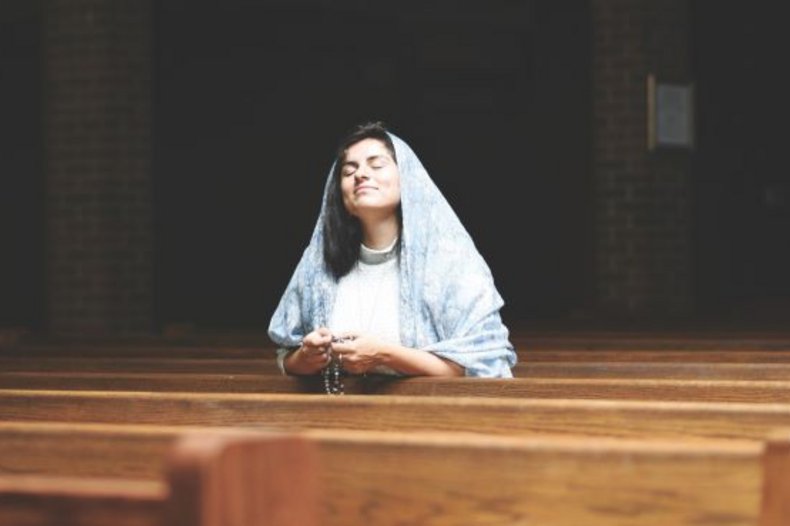
Unsplash/Josh Applegate
Les raisons d'y croire :
- Teresa Musco's moral uprightness and beautiful human qualities preclude any suspicion of fraud or deceit. Her obedience to the ecclesiastical authorities and her humility were universally acknowledged.
- Both the messages Teresa received and the interpretation she gave of the miraculous phenomena surrounding her are in perfect resonance with the teaching of the Catholic magisterium, and in full continuity with the Gospel.
- No scientist to date has been able to explain the unusual facts of Teresa's life. For example:
- Teresa received the stigmata in August 1952. There couldn't be unexplained by science, and were not self-inflicted wounds - it is also important to note that her psychological evaluation showed no masochistic or schizophrenic tendencies. Additionally, the clinical changes of the wounds did not follow any natural pattern.
- During her ecstasies and prayers, Teresa spoke a language unknown to those around her. When Don Carlo de Ambrogio, a specialist in Semitic languages, came to visit Caserta, he discovered that Teresa spoke Aramaic, the language spoken at the time of Jesus. Teresa had never learnt the language, however.
- Over a period of eighteen months, a series of phenomena were observed in Teresa's room, consisting of weeping (clear or bloody tears) or perspiring holy images or statues. Hundreds of people from all walks of life witnessed these manifestations and attested to their occurence either verbally or in writing. Blood issuing from a crucifix was analysed by a doctor in 1975 and found to be human blood.
Synthèse :
Father Gabriele Roschini notes at the outset: "During my long religious life, and even more so during the long period when I was consultor to the Congregation for the Causes of Saints, I had the opportunity to read and sift through a large number of biographies of holy souls from all times and backgrounds, exceptional souls endowed with extraordinary gifts [...]. None of them [...] can compare with the extraordinary life and phenomena of Teresa Musco. For me, [...] the name of Teresa Musco represents the greatest phenomenological whole of all times and places" (preface to Father Stefano Manelli's book Piccola storia di una vittima).
Teresa Musco was born on July 7, 1943, in Caiazzo, Italy, in the province of Caserta, near Naples, in a typical poor southerm Italian family of farmers. Her father Salvatore was an angry and abusive man, while her mother, Rosa "Zullo", was gentle and devout. The couple had ten children, four of whom died during childhood. The first years of Teresa's life were rather bleak: the fighting of the Second World War raged in the south of Italy, disrupting farm work and hampering food supplies. From an early age, Teresa helped her parents with the housework.
At the age of seven, she felt for the first time the mysterious presence of the Virgin Mary, to whom she was already deeply devoted. From an early age, Teresa was aware of Mary's role in the economy of salvation, namely to lead people to her Son Jesus.
From 1950 onwards, she suffered from high fevers and painful colic, but no one was able to identify the cause. Teresa did not attend school until the age of nine, and then only sporadically.
She had her first mystical experience at the age of 5. The visions were frequent: she saw Jesus, Mary, angels and saints... Again, we must rule out hallucinations or illusions since her ecstasies and visions didn't arise from morbid states known to psychiatrists, but on the contrary brought inner peace and wisdom to Teresa who, far from being "predisposed" or "a model of sanctity", was a sometimes turbulent and mischievous little girl, "a whirlpool of energy", as she herself put it.
On the afternoon of January 9, 1948, a rainy day, while praying the rosary with her family near the fireplace, Teresa suddenly fainted. One of her feet fell on the blaze. When she came to, she screamed in pain. Three days later, she saw a "beautiful Lady",who dressed her burns. Eight days later, all traces of the burn had disappeared from the surface of her skin.
On the following January 21, the Virgin appeared to her again: "My daughter, I am your heavenly Mother, guiding you along the path that is pleasing to my beloved Son." After that, Teresa began receiving an increasing number of prophetic messages: for example, she knew about her eventual move to Caserta (when she had to leave her childhood home) and a thousand details of her future adult life. Can we ascribe these to an overactive imagination? Not in this case: the content of Teresa Musco's visions and of the messages are far beyong her natural cognitive abilities and level of education. When she was just five years old, the Child Jesus asked her: "Teresa, do you love me?" She replied: "Yes! And do you love me?" Staring at her, the Lord replied: "I do! Yes ! And if need be, I would be ready to be crucified again for you."
Teresa also desired to receive Holy Communion from a very early age, a fact that is common among authentic mystics. The parish priest at Caiazzo allowed her to make her First Communion before she was twelve, but her father objected, and the question of how to prepare for the ceremony turned into a family drama. On January 10, 1950, Teresa stayed in her room, wracked with pain. Jesus appeared to her, stretching out his arms towards her, and said: "Prepare your heart to receive me in Holy Communion, for I desire to come to you, so that the two of us may become one." That same day, at about half past ten, her father ordered her to get up and go cut some grass. Teresa obeyed. She got dressed and set off for the fields around the village. Then she heard a voice: "This is one of my houses." Looking around, she saw a small church, so she interrupted her work and made her way to it. She entered slowly, because she had heard noises inside: a wedding mass was being celebrated. She saw a priest in one of the confessionals, who agreed to hear her confession. During communion, she fearfully approached the altar rail, like the others, and received Jesus in the Host.
That day, the Virgin asked her to write down what she said, because the time would come when she would have to entrust her messages to priests. One day in 1950, Our Lady warned Teresa that from then on she would have "much to suffer". Without understanding the meaning of these words, Teresa nodded. Then the angel Gabriel told her: "You will go up to Calvary with Jesus". In fact, Teresa's health was to suffer greatly until her death. In all, she had 117 operations.
Some of Teresa's experiences are worth mentioning. On January 3, 1952, Mary said to her: "I appeared in Portugal where I gave messages, but nobody listened to me [...]. I'm going to tell you about the third secret I entrusted to Lucia at Fatima. I can tell you that it has already been read, but no one has spoken about it." Father Roschini added: "Our Lady foretold Teresa of Paul VI's journey to Fatima, where he would invite everyone to prayer and penance, and she also confided that the Pope would not dare to speak of the secret, because it was terrible."
Other prophecies would emerge as the months went by: so many calls to prayer, penance and conversion. One morning, as she arrived at the village church for Mass, she saw a priest coming towards her, dressed in a monk's habit. He said to her: "My daughter, I recommend that you pray for the salvation of the souls in purgatory." - "Who are you?" -"I am Padre Pio. Jesus told me to tell you not to talk to anyone about what is happening to you. One day, you will be like me. Look..." He showed her the stigmata on his hands, blessed her and disappeared. Did Teresa suffer from a mental illness? Certainly not! At the time, Teresa was unaware of Padre Pio's existence. Pictures and photographs of him were rare, and it's hard to imagine that the little girl would have found a copy in a magazine, or at home, in her church or at school.
On August 1, 1952, she saw Jesus on a road "full of thorns". The Lord asked her: "Daughter, will you help me carry this Cross?" Two strangers came up to her, laid her on a cross and nailed her to the wood. Teresa woke up in profuse perspiration. She felt excruciating pain in her hands, feet and chest. She noticed that blisters had formed in these areas. She was stigmatised. An argument propounding self-mutilation or wounds formed by autosuggestion would be completely unfounded: Teresa's psychological disposition in no way suggests masochistic or schizophrenic tendencies. What's more, the clinical evolution of her wounds was medically unpredictable.
In 1954, Teresa received her "life mission" from Our Lady: "God alone for goal, Jesus for model, Mary for guide, your guardian angel for support, and myself in sacrifice." The rest of her life consisted in meticulously fulfilling this mission. On April 12, 1955, lying on her bed, Teresa saw a great ray of sunlight in the centre of which an angel said to her: "You have accepted the cross, and soon you will reach Calvary. When you get there, your body will be like a crucifix and your heart like a living tabernacle."
God gave her several extraordinary charisms: she could read hearts and speak in "unknown" languages. Father Franco Amico, a priest who knew Teresa Musco, testifies: "Many people wondered what language Teresa spoke during her ecstasies [...]. From Don Stefano Gobbi himself, I received the following explanation. On February 1, 1975, Don Carlo de Ambrogio came to visit Caserta. This priest was a specialist in Semitic languages and was responsible for the translation of psalms. When Teresa began to speak Aramaic in his presence, he asked her to pronounce each word slowly. Don Carlo was able to grasp the meaning of each word and said that the language spoken by Teresa was the same as that spoken at the time of Jesus."
On November 7, 1960, following a vision from the Angel Gabriel, Teresa decided to leave her parents' home and go to Caserta, as Mary had foretold. She made an act of complete abandonment to God. These years were marked by the devil's vexations and oppressions against her. She complained about this to Jesus, who replied: "My daughter, you must be ground like grain and pressed like a bunch of grapes." This response evokes the testimony of the philosopher Maurice Clavel (d. 1979), of whom Teresa was obviously unaware, who explained that at the time of his conversion he had been "scoured like a sink".
Jesus asked her to pray unceasingly for the souls in Purgatory. Teresa often received requests to pray for these souls, who sometimes manifested themselves to her, confirming the Church's teaching on this point.
On October 15, 1963, she took a vow of virginity. Her mystical life progressed, despite diabolical attempts to demoralise her. Unexplained phenomena were a daily occurrence, and Father Franco Amico, who assisted Teresa in the last years of her life, bore witness to them, as did hundreds of other direct witnesses.
An initial scientific analysis was drawn up in 1974 and included in Father Gabriele Roschini's report of the events, Extraordinary phenomena verified at Castel San Lorenzo. These also took place at the home of one of Teresa's brothers, Luigi Musco.
In the last days of July 1974, an image of the Virgin Mary in the image. On October 5, the face of that same image showed visible perspiration. On October 21, the image shed tears of blood in the presence of many people.
Between February 26, 1975, and August 19, 1976, several priests and scientists rigorously observed the manifestations: tears (normal or bloody) flowed from twenty-four religious objects (images, photos, or statues). Doctor Francesco Guarino, after detailing the protocol and technical procedures, concluded: "The blood type is O+" . Father Roschini put the number of events recorded at Teresa's home in Caserta alone at "approximately 757".
Teresa was a "victim soul": a believer who accepts all evils in order to offer them to Jesus for the salvation of sinners. This is the heart of her spirituality. On the feast of the Assumption in 1974, she saw "a beautiful Lady" whose "voice was like a melody"; "luminous rays came out of her hands", dressed in white, with a blue sash and a cloak "the colour of heaven", her "feet rested on a white cloud". She said to the mystic: "My daughter, I am in your midst to see who wants to offer himself as a victim on this earth so that he can then enjoy the reign of my Son. Will you accept?" Teresa accepted without hesitation.
The Eucharistic sacrament is a central theme of the messages she received. On December 23, 1975, Jesus exhorted her to focus on adoring the Blessed Sacrament: "My daughter, may I be consoled and repaired in my Eucharist... I desire love through the Eucharist and my holy wounds." In a word, Father Roschini wrote, Teresa flew "to the highest heights of love, to be immolated with the Victim of victims, Jesus."
In the early days of April 1976, Teresa's health deteriorated. The wounds of the Passion made her suffer atrociously. On June 23, 1976, she was taken to the civil hospital in Caserta for a nephrology test and diagnosed with "chronic uraemia with high blood pressure".
Shortly afterwards, a doctor asked to examine the stigmata. Believing it had a medical cause, he sent Teresa to another hospital in the city for a consultation in dermatology. The hospital practitioner's response was definitive: "These aregenuine stigmata". In her room, roses that had been given to her, placed in front of a small image of the Immaculate Heart of Mary, mysteriously filled with dew.
On July 9, Teresa had her first haemodialysis. She fell into ecstasy for the last time, and saw and heard the Virgin Mary tell her: "You will suffer a little longer, and then I will take you to the Father". On August 19, 1976, Teresa Musco lay exhausted on her bed. She still found the strength to endure a final dialysis treatment. In the waiting room, she met a woman in pain who asked her why God allowed so much suffering: "The Lord forgets nothing: he will know how to reward us for our suffering", she replied.
At that moment, Teresa's heart showed signs of extreme weakness. Suddenly, the bells of a nearby church rang out: "It was to call the faithful to make reparation for a sacrilege committed on consecrated hosts", people were told. The nurses went to church together, and Teresa remained alone. In the spring of 1972, she had asked Mary to die in absolute solitude.
The bishops of the Campania region authorised the opening of the diocesan phase of Teresa's beatification process in October 2004.
Patrick Sbalchiero
Aller plus loin :
Short story of a victim : Teresa Musco (1943-1976), by Stefano M. Manelli and Johanna Pearson (Ed. "Terzo Millenio", Italy, 1984)









